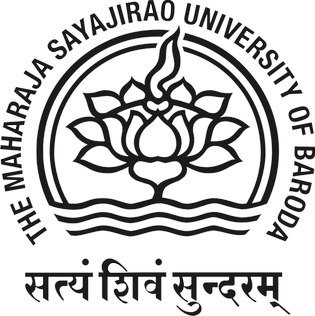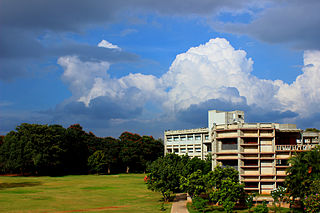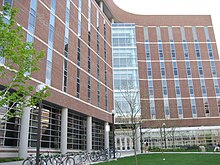
The Marine Biological Laboratory (MBL) is an international center for research and education in biological and environmental science. Founded in Woods Hole, Massachusetts, in 1888, the MBL is a private, nonprofit institution that was independent for most of its history, but became officially affiliated with the University of Chicago on July 1, 2013. It also collaborates with numerous other institutions.
Stanford University School of Medicine is the medical school of Stanford University and is located in Stanford, California. It traces its roots to the Medical Department of the University of the Pacific, founded in San Francisco in 1858. This medical institution, then called Cooper Medical College, was acquired by Stanford in 1908. The medical school moved to the Stanford campus near Palo Alto, California, in 1959.

Maharaja Sayajirao University of Baroda, formerly Baroda College, is a public university in the city of Vadodara, Gujarat, India. Originally established as a college in 1881, it became a university in 1949 after India's independence. It was later renamed after its benefactor Maharaja Sayajirao Gaekwad III, the former ruler of Baroda State.

The department of plant and microbial biology is an academic department in the Rausser College of Natural Resources at the University of California, Berkeley. The department conducts extensive research, provides undergraduate and graduate programs, and educates students in the fields of plant and microbial sciences with 43 department faculty members.
The University of Texas Southwestern Medical Center is a public academic health science center in Dallas, Texas. With approximately 23,000 employees, more than 3,000 full-time faculty, and nearly 4 million outpatient visits per year, UT Southwestern is the largest medical school in the University of Texas System and state of Texas.

National Centre for Biological Sciences (NCBS) in Bangalore, Karnataka, is a research centre specialising in biological research. It is a part of the Tata Institute of Fundamental Research (TIFR) under the Department of Atomic Energy of the Government of India. The mandate of NCBS is basic and interdisciplinary research in the frontier areas of biology. The research interests of the faculty are in four broad areas ranging from the study of single molecules to systems biology. Obaid Siddiqi FRS was an Indian National Research Professor and the Founder-Director of NCBS. He made seminal contributions to the field of behavioural neurogenetics using the genetics and neurobiology of Drosophila.
The University of California, Davis College of Biological Sciences was established in 2005 and is one of four colleges and five schools on the campus of the University of California, Davis. Davis is the only UC campus that boasts a college dedicated solely to the study of biology, and is one of the only universities in the US to have such an institution. The college offers ten undergraduate majors and six minors, and has eight interdisciplinary graduate groups. The majors housed in the CBS were previously part of the Division of Biological Sciences since 1971.

The University of Veterinary and Animal Sciences, or UVAS originally known as Lahore Veterinary College, is a public university located in Lahore, Punjab, Pakistan.

The College of Sciences at the University of Texas at San Antonio in San Antonio, Texas is a college in science and research education. The college hosts more than 5000 students enrolled in fifteen undergraduate and sixteen graduate programs. The seven departments employs 286 tenure and non-tenure track faculty members. Students are exposed to collaboration through programs with local external research institutions including UT Health Science Center, Southwest Research Institute and the Southwest Foundation for Biomedical Research.
The School of Biological Sciences is a School within the Faculty Biology, Medicine and Health at The University of Manchester. Biology at University of Manchester and its precursor institutions has gone through a number of reorganizations, the latest of which was the change from a Faculty of Life Sciences to the current School.

The College of Natural Science (NatSci) at Michigan State University is home to 27 departments and programs in the biological, physical and mathematical sciences.
Norman Richard Pace Jr. is an American biochemist, and is Distinguished Professor Emeritus of Molecular, Cellular and Developmental Biology at the University of Colorado. He is principal investigator at the Pace lab.
North Carolina State University's College of Agriculture and Life Sciences (CALS) is the fourth largest college in the university and one of the largest colleges of its kind in the nation, with nearly 3,400 students pursuing associate, bachelor's, master's and doctoral degrees and 1,300 on-campus and 700 off-campus faculty and staff members.
The College of Science and Engineering is one of the three colleges of the University of Edinburgh. With over 2,000 staff and around 9,000 students, it is one of the largest science and engineering groupings in the UK. The college is largely located at the King's Buildings campus and consists of the separate schools of:

Faculty of Biology of the Belarusian State University was founded in 1931. It is a major biology research and teaching establishment in the country, which includes nine Departments and nine Research Laboratories. The Dean is Vadim Viktorovich Demidchyk, Docent, Doctor of Sciences
The UCPH Department of Biology is a department under the Faculty of Science at University of Copenhagen (UCPH). It is organized in 10 sections and is also involved in a number of research centres. The department offer three BSc and four MSc degree programmes. With 400 employees and 1,800 students, it is the largest department at the faculty. It also operates the Øresund Aquarium in Helsingør.
Ruth Geyer Shaw is a professor and principal investigator in the Department of Ecology, Evolution and Behavior at the University of Minnesota. She studies the processes involved in genetic variation, specializing in plant population biology and evolutionary quantitative genetics. Her work is particularly relevant in studying the effects of stressors such as climate instability and population fragmentation on evolutionary change in populations. She has developed and applied new statistical methods for her field and is considered a leading population geneticist.

The Archives of Biological Sciences is a multidisciplinary journal that covers original research in a wide range of subjects in life science, including biology, ecology, human biology and biomedical research.
Kim Orth is a microbiologist and biochemist. She is the Earl A. Forsythe chair in biomedical science and professor of molecular biology and biochemistry at UT Southwestern. She is a Howard Hughes Medical Institute investigator and a member of the National Academy of Sciences. Her research focuses on bacterial pathogenesis.











